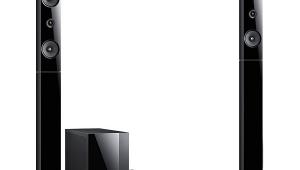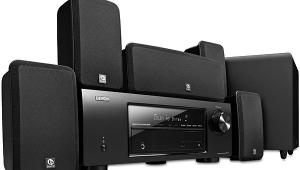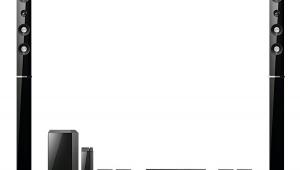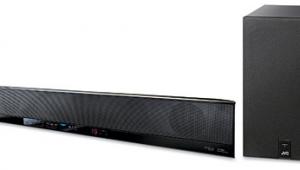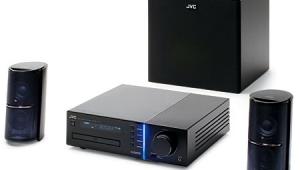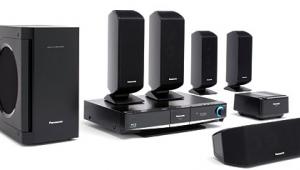Cambridge SoundWorks SurroundWorks 200 Virtual Home Theater System
Virtual surround is nothing new: Some people don't have the space, the know-how, or perhaps the ideal room layout for a pair of surround speakers for true 5.1-channel audio. Wireless surrounds are an option for some. But even those need a place to live, and they still require power cables. All manner of technologies have addressed the virtual-surround challenge, but not until I tried the two-piece Binaura Sound Environment B102A (in our November 2005 issue) did I believe that such simplified gear could produce truly respectable audio. Cambridge SoundWorks of Newton, Massachusetts, is the first third-party manufacturer to license Binaura's patented technology for their own products. They have integrated it into a complete home theater system—three boxes instead of two—with the addition of a progressive-scan DVD player/receiver. Said receiver provides Dolby Digital 5.1, Dolby Pro Logic II, and DTS decoding, and this signal then goes to the subwoofer, where all of the amplification and Binaura processing take place.

The system centers around the AVS600 DVD tuner/preamplifier console, the same unit Cambridge includes in their HTIB MegaTheater systems. One nice perk of this arrangement is a built-in upgrade path, should you ever decide to switch to full discrete 5.1. A D-Sub 15-pin cable connects the AVS600 to the subwoofer, but the AVS600's back panel also offers an RCA-type six-channel direct output, which can work with amplified speakers or a six-channel amp, in addition to a digital optical output. The slim front panel sports tiny but informative readouts and a set of A/V inputs. The subwoofer bundled with the SurroundWorks 200 package is unique, however. While MegaTheater subs use an 8-inch sealed enclosure with 150 watts of dedicated power for the woofer and 300 watts (60 watts times five) for the mains, this significantly smaller sub incorporates a 6.5-inch active driver with an 8-inch passive radiator instead of a port. The total power of 225 watts RMS (75 watts for the sub plus 50 watts each for the left, right, and center channels) is almost double that of the original, first-party Binaura system, and that extra juice makes an obvious difference. The BASH amplification Cambridge employs is more sophisticated than Binaura's. Maintaining Binaura's specs, the circuitry works best with full-range drivers in a predetermined dispersion pattern, as in the main speaker. But Cambridge has redesigned the drivers to handle the higher power, while added electrical equalization combats what some considered to be an overly aggressive midrange response in the Binaura center channel.
After you secure the D-Sub cable between the AVS600 and the sub, a Christmassy (or quasi-Italian) red/white/green RCA-terminated cable connects to the magnetically shielded main speaker via a proprietary termination. The cable is somewhat thick and stiff, and its placement at the rear bottom center of the speaker is awkward, as it tends to push the speaker up when it rests on a flat surface. The supplied cabling also provides a curious miniplug on the RCA end, one that could patch into the Mode Control port on the back of the sub, but Cambridge specifically instructs you not to use it as part of this setup. Further investigation reveals that the Mode switch on the main speaker—Mute, Surround, Dialogue, and Stereo options—is moot, as well, since the AVS600 automatically makes all of the necessary adjustments. In essence, the prominently placed knob does nothing, and the miniplug just dangles, even though, at press time, the only way to buy the Cambridge virtual surround speaker/sub combo is bundled with the AVS600. This strikes me as odd. The DVD player is fairly standard to configure, with a convenient I/P (interlaced/progressive) button on the remote. Just be sure to hit Stop twice if you were playing a DVD. Otherwise, you won't be able to change the deinterlacing mode or the aspect-ratio settings. A well-laid-out universal remote control is included.
 Working with test discs revealed that the deinterlacing is subpar, with pronounced jaggies besetting the edges of objects in motion, in both test patterns and traditional video content. The 3:2 pulldown correction gauntlet exposed an unpleasant combing. I gained some relief when I manually switched the video modes to match the content. (The AVS600 offers four, in addition to the hardly-ever-correct Auto.) But even this didn't alleviate the problem entirely. When I switched to some popular DVDs, I was distracted by a prevalent twitchiness on the finer textures of Superman; a good amount of detail was lost in the wash of conspicuous processing in many shots. More modern, reference-quality video makes a better showing on this player, like the all-digital Star Wars: Episode II, flaunting its excellent blacks and shadow detail.
Working with test discs revealed that the deinterlacing is subpar, with pronounced jaggies besetting the edges of objects in motion, in both test patterns and traditional video content. The 3:2 pulldown correction gauntlet exposed an unpleasant combing. I gained some relief when I manually switched the video modes to match the content. (The AVS600 offers four, in addition to the hardly-ever-correct Auto.) But even this didn't alleviate the problem entirely. When I switched to some popular DVDs, I was distracted by a prevalent twitchiness on the finer textures of Superman; a good amount of detail was lost in the wash of conspicuous processing in many shots. More modern, reference-quality video makes a better showing on this player, like the all-digital Star Wars: Episode II, flaunting its excellent blacks and shadow detail.
But, since the sonics were what would ostensibly set the Cambridge SurroundWorks 200 apart, I eagerly popped in The Patriot to see what this one speaker and sub could do with the multiple channels of voices and rifle fire. The additional wattage gives the system formidable power for a drive-the-wife-crazy loudness that you can palpably feel. The Binaura effect creates a definite directionality, even though what would have been the surrounds instead tended to sound more like left and right mains, with a modest amount of information seeming to come at me from the sides, too. Still, considering that there was nothing but air and a wall behind me, this was basically a convincing surround soundfield.
The mighty Master and Commander did not fare as well at high volume, as a disagreeable quiver was introduced to raised voices, and the prolonged battle sounds are a seemingly endless string of painful distortions. Too often, the wind around the ship sounded like a wind tunnel, hollow and inherently fake. The good news is that you will likely never need it that loud in normal use, although I would suggest keeping the effortless sub at full gain, as it does wonders for the system's total impact. As I've mentioned in previous reviews, there is a moment within the first big battle of Master and Commander where the viewer is below deck while the crew is scurrying above, and the footsteps seem to originate noticeably higher than the listener. This is a wonderful "you are there" simulation if reproduced correctly, as is indeed the case with the SurroundWorks 200.
DVD-Audio playback was inconsistent, as some discs would begin playing immediately, bypassing the menus, while others would give me the onscreen options. More often than not, however, tracks would begin playing abruptly, cutting off a portion of the first note of each song. And the sound quality was in no way impressive: I cannot recommend this system for the proper reproduction of DVD-Audio's higher resolution.
The SurroundWorks 200 is definitely about absolute convenience, with just three boxes and two audio cables for the illusion of 5.1-channel soundtracks from DVDs. Incorporating Binaura's patented technology makes this trick a reality, but, along the way, Cambridge's boost in power apparently led to a loss of some refinement—and to sonic compromises not evident in the first-party original system. Still, the sheer clout of 225 watts is undeniable. I do wish that the DVD picture quality was more filmlike, however, especially in a $1,000 HTIB system.
Highlights
• A complete virtual surround package with just a DVD receiver, a main speaker, and a sub
• DVD-Audio playback in addition to DTS, Dolby Digital5.1 , and Dolby Pro Logic II
• Remarkably convenient with an interesting surround effect—but not ideal reproduction
- Log in or register to post comments
